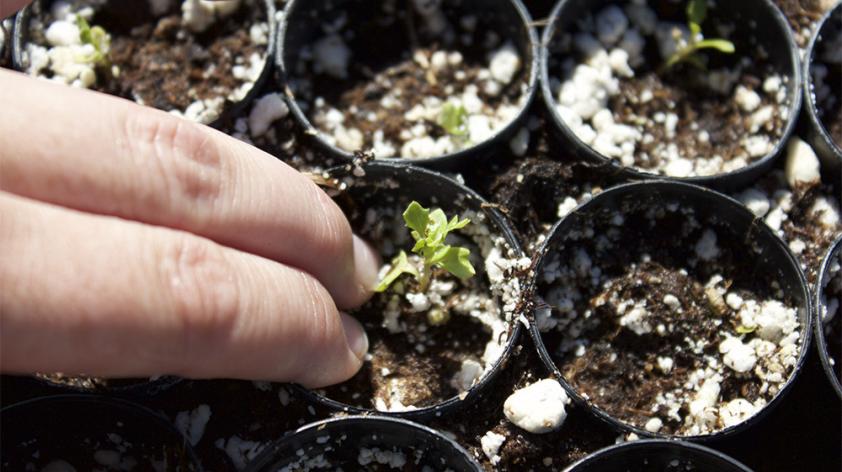
Seeding the Future
Transplanting fragile seedlings is a delicate but rewarding task.
As a kid growing up on a ranch in rural Colorado, I never enjoyed sowing seeds or weeding in my mom’s vegetable garden. Ask me to feed the chickens, okay. Fix barbed wire fence? Sure! Do anything involving a horse? You bet! But spend an afternoon with a hoe and unending rows of potatoes? No way. I often reflect on that now when I’m working in the nursery at the Beckman Center leading a team of dedicated volunteers in propagating 20,000 native shrubs over the course of two years. Somehow a switch flipped in my thinking about tending to plants as soon as I started growing natives for restoration. Now I see time spent sowing, transplanting, and watering seedlings as some of the most enjoyable and relaxing aspects of a job that I love. The volunteers and I began propagating almost 20 species in April, and we’ll spend the summer and fall nurturing just over 10,000 plants to grow into half-gallon pots by the winter planting season.
Native plant seeds are sprouted and raised in the nursery area at the Beckman Center for Conservation Research.
The plants that we’re growing here will be the foundation of restored habitat for myriad plants, animals, invertebrates and fungi that depend on quality Coastal Sage Scrub (CSS) habitat. I often find myself enchanted by the tiny, miniature versions of California sagebrush Artemisia californica, bladderpod Peritoma arborea, and white sage Salvia apiana growing in neat rows of pots, just waiting to get big enough to get transplanted into our restoration site at Lake Hodges. I’m excited about this project, which is a mix of applied restoration and theoretical research. We’re restoring over 20 acres of degraded CSS habitat that is part of a critical corridor of preserved land in San Diego County. CSS is declining throughout its narrow range in southern California, so we’re doing all we can to preserve and restore the CSS vegetation at Lake Hodges that was burned in 2007. Lake Hodges is the centerpiece of the San Dieguito River Park, a patchwork of open space extending from the coast near Del Mar up into the mountains of Julian. The Park is home to many of the rare species that contribute to San Diego County’s astounding level of biodiversity.
These seedlings will be used to help restore Coastal Sage Scrub habitat at Lake Hodges.
Diversity is the focus of the research we’re growing plants for. We’re interested in how diversity affects the success of restoration efforts, so we’ll be planting in blocks that vary in number of species. If a block dominated by, say, California buckwheat Eriogonum fasciculatum performs better than a mixed block of eight different native shrub species, we may be able to refine our planting methods for future work accordingly. It’s this mix of working closely with native plants while trying to figure out what makes the system in which they’re embedded tick that makes me love restoration. The last eight years of so of growing native plants for work has also made me revisit my childhood dislike of vegetable gardens—I guess I better tell my mother I’ll help her weed those potatoes next time I’m home!













